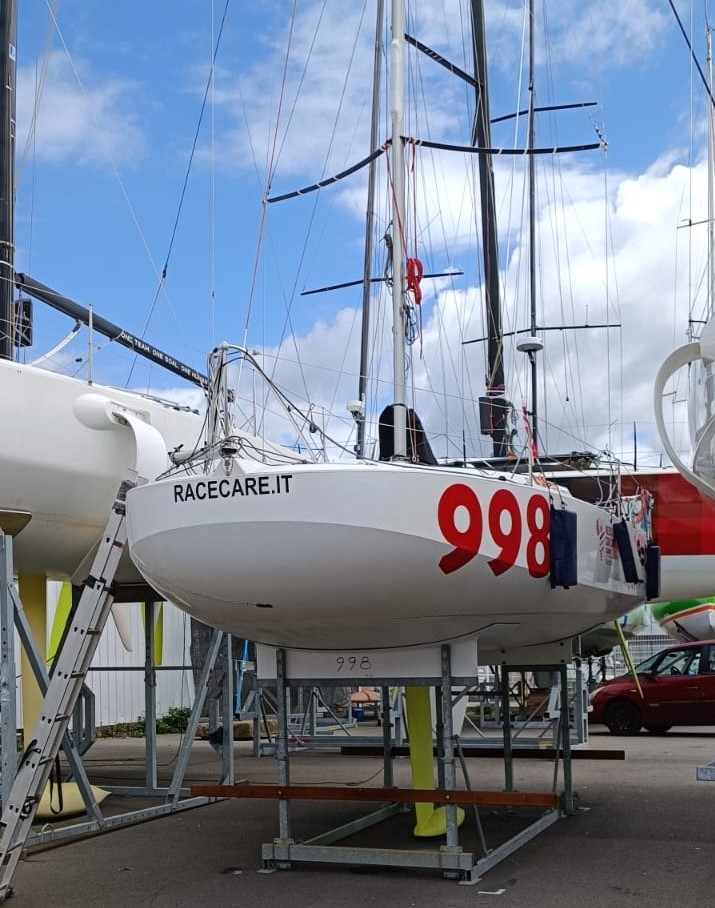
Preparation:
Having just finished a regatta, I am finally more relaxed and everything is ready. I can focus on the details: resting, studying navigation, weather conditions, and taking care of the final little things on the boat. It may seem like everything is optimized and repaired, but there are always tasks to be done. From a tactical and strategic perspective, the regatta seems simple, at least until the moment of heading back up from Ile de Re. On the other hand, the stretch to go north is really tough, close-hauled for almost 24 hours amidst 3-meter waves and 25/30 knots of wind. It’s not a pleasant situation, but I’m surprised by how calm I am. I have confidence in my abilities and in my boat. I’m ready to take the challenge!
Day 1:
Jib or Code 0? The first tack to exit the bay immediately poses an important dilemma
The wind is supposed to increase and shift against us, which would not allow the use of the larger sail. However, at the moment, it seems like it could work. Well, I’ll set it up.
No… the wind is picking up… I’ll put it away… Wait, it was just a passing cloud, damn it. Now it’s working perfectly.
I’ll set it up again. But why? Why am I letting myself be plagued by these doubts?? Oh damn… less than 10 minutes until the start
I need to hurry. I’m already too far from the starting line and there we go… a bad start, but at least I have my Code 0 up, which…
…Isn’t working! The wind has shifted as predicted. I’m a bit behind in exiting the bay, and I’m struggling compared to my competitors in the upwind leg. I have good speed but a poor angle. What am I doing wrong?
Ease the jib a bit, tweak the mainsail a bit, there we go, now we’re in phase with the wind shifts and we’ve found our rhythm.
The wind is picking up… But wasn’t it supposed to be 25/30 knots?
The wind is increasing, and consequently, the sea as well? But wasn’t it supposed to start dying down around 7 p.m.?
We’re in a cold wind that keeps knocking the boat down. There are steady 30 knots and gusts at 36/37 knots.
But the boat and I are sailing well, and the strategy so far has been excellent. We’ve caught up with the leading pack and are still sailing fast.
Night falls…
Day 2:
A freezing night, but the wind is starting to become more manageable.
Every now and then, I can finally go below deck and try to warm up a bit.
I decide to pass through the Glenan Islands. It’s an area full of rocks, but at least I’m more sheltered from the sea, and the current is favorable.
I gain more ground. I’m in the leading pack. Good. The race is still long, and soon the downwind leg with a strong wind will come. Conditions in which I have already proven to be a challenging beast to handle. It will be excellent training for the Transat.
And what about the passage of Raz de Sein? How will it be? We’re a bit behind compared to the routing. I need to move to arrive before the current becomes unfavorable.
Oh no… the boat has tacked. Why is the steering slow? What’s happening? And the jib is moving abnormally.
No… don’t tell me… no. I don’t even want to think about it…
I go forward, fearing the worst. The forestay is sliding through the jib. Damn, I could dismast. Tack. Put a halyard to save the mast. Hurry!
Can I continue the race? No, too risky. I would only damage the equipment.
I need to turn the boat around and head towards the port.
Damn… goodbye chance of competing in the French championship. This retirement is too heavy…
The Retirement:
Fortunately, I’m not one to abandon races easily.
The route to Lorient, luckily, is downwind. I proceed with reduced sails to avoid putting too much stress on the mast.
We proceed calmly. Thoughts fill my head. What to do? The best thing is to take advantage of this moment of tension easing to get some sleep. The arrival in the port is always very delicate, and there will be no one to help me. I need to regain physical and mental energy to handle the maneuver as best as possible.
Meanwhile, the persistent thought is: how is it possible that the forestay attachment broke? I had done a thorough check on the mast this winter, changed the rigging, but not that piece… no one had ever broken that piece before me, especially on a barely four-year-old mast.
Upon my arrival at the port, to my surprise, I see many boats. And just after finishing mooring, I see two more competitors arriving, who help me tidy up the sails. How strange… what happened?
I find out that the conditions had indeed been harsh. It wasn’t just my imagination, and the fleet had been decimated. About 50 boats out of the 100 that started had retired.
What a bitter feeling to have to abandon the race just after the worst moment had passed. The real fun would have started shortly after…
But that’s sailing, and above all… better now than in the Transat!



